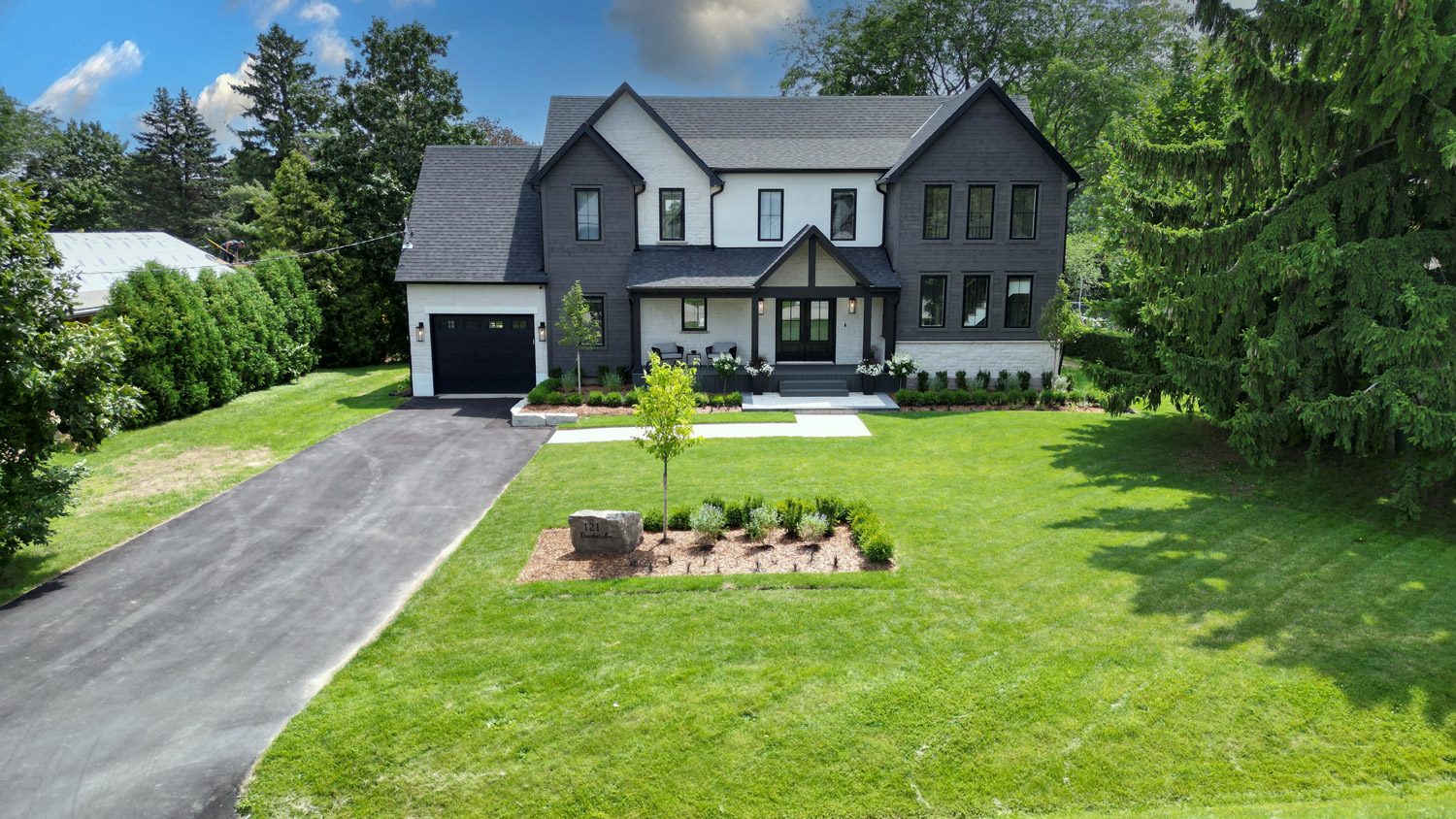
9 Steps Homeowners Should Know Before Building a Custom Home in Ontario
Building a custom home is one of the most personal and rewarding decisions you’ll ever make.
You’re not just constructing walls and rooms—you’re shaping your lifestyle, routines, and future under one roof. The experience can be exciting and empowering, especially when you work with professionals who truly listen and understand your goals. But to make confident, informed decisions, you need more than inspiration—you need clarity, structure, and the right partner.
For homeowners across Toronto, Oakville, and Burlington, custom home building means more than just choosing finishes. It involves coordinating with architects, trades, and municipalities, balancing budgets with ideas, and solving design challenges with purpose. Planning well and knowing what to expect at every step will make all the difference. When done right, the process gives you control, transparency, and peace of mind. A strong foundation—both literal and procedural—sets everything else in motion.
You’re not just constructing walls and rooms—you’re shaping your lifestyle, routines, and future under one roof.
What to Consider Before Custom Home Construction Starts in Toronto
Planning custom home construction in Toronto starts well before any shovel hits the ground. This is the stage where your ideas need to align with real constraints, such as zoning bylaws, neighbourhood context, and the shape and grade of your lot. Whether you’re in a heritage zone, dealing with unique setbacks, or facing size restrictions, each element must be considered early. Having local expertise on your side at this point prevents missed approvals or budget overruns.
Toronto homeowners are often surprised by how different the process can feel depending on the specific district or even the street. Infill lots may require additional reviews, and corner properties often come with their own design and access regulations. If you already own land, a preliminary site assessment can help you understand what’s feasible. If you’re still searching, your builder or architect can help evaluate a lot of conditions before you commit.
9 Steps Homeowners Should Know Before Building a Custom Home
1. Define a Clear Budget and Project Scope
Before anything is drawn or designed, your custom home needs a financial outline that reflects both your goals and limitations. A clearly defined budget protects your project from growing beyond what you’re prepared to invest and sets a benchmark for every design and material decision that follows.
Break your budget into key categories such as land, permits, soft costs (engineering, design, surveys), hard construction costs, and a contingency. It’s also smart to leave space for future upgrades or post-move-in expenses. Be realistic about timelines and seasonal conditions that could affect cost, particularly in Ontario. With a clear scope and financial plan, you’ll reduce friction and make faster, smarter choices throughout.
2. Choose the Right Lot in Your Target Ontario Community
Your location shapes everything from design to permit requirements to how your home performs throughout the seasons. Whether you’re planning to build in Toronto, Oakville, or Burlington, understanding lot orientation, size, slope, soil condition, and setbacks is essential.
Some communities may have stricter guidelines around tree protection, grading, or architectural controls. A lot with existing infrastructure or easy utility access can significantly reduce preparation costs. Consider your proximity to schools, transit, and daily conveniences if the home is for long-term use. Early site evaluation ensures your dream design can actually be built where you want to live.
3. Align with a Builder Who Offers Design Support
Many homeowners assume they must choose between a separate architect and builder, but an integrated design-build team often leads to better alignment, cost control, and communication. The builder you choose should be deeply involved in helping shape a realistic design that fits your style, budget, and priorities.
Look for a team that collaborates with your architect or provides one in-house, and who can walk you through each design phase while accounting for build feasibility. Ask how design decisions are reviewed alongside pricing, and how construction feedback is incorporated early. This partnership ensures the home you imagine is both beautiful and buildable. Trust, responsiveness, and shared values matter more than checklists.
4. Finalize Your Custom Home Floor Plan and Layout
Once the concept is shaped, detailed drawings bring the project into sharp focus. Your floor plan should reflect how you live now, but also account for how your family or needs may change. Consider flow, natural light, storage, and the relationships between spaces, not just their size.
Think practically about entry points, traffic patterns, future accessibility, and lifestyle zones. Make room for built-in flexibility, such as office nooks or potential guest suites. Site orientation will influence where you place windows and living spaces to maximize daylight and seasonal comfort. These decisions add function and value far beyond aesthetics.
5. Submit Plans and Begin the Permit Application Process
With drawings in place, your builder or designer will help prepare submission packages for zoning and building permits. Depending on your location, this process can take weeks or even months, especially in parts of Toronto or Oakville with layered municipal reviews.
Timelines will vary based on whether your project is considered minor variance or falls within standard zoning permissions. Be prepared to respond to city feedback or make small revisions. Your team should also coordinate structural engineering reviews and coordinate energy modelling if required. Good documentation prevents delays, so ensure accuracy and completeness upfront.
6. Prepare for Excavation and Foundation Construction
Once permits are secured and the schedule is confirmed, site work begins. Excavation requires surveying, staking, and preparation based on your soil conditions and basement design. Toronto and surrounding areas can present a mix of sandy, clay, or rocky soil—each of which influences the approach to excavation and footing design.
Your foundation is one of the most critical stages of the home construction process. It must be waterproofed, structurally sound, and sized to accommodate insulation, utilities, and framing connections. After pouring and curing, inspections ensure compliance before the next stages begin. Early trades like plumbing and electrical rough-ins often start before backfilling.
7. Make Structural and Framing Choices That Support Longevity
Your home’s structure must meet both code requirements and long-term durability standards. This includes how floors are supported, the spacing and materials used in your framing, and how loads are distributed. For clients in Oakville or Burlington, framing options may also consider energy performance and materials that resist local climate conditions.
Choose framing details that support the insulation and mechanical systems you plan to install. Engineered joists or sheathing upgrades can add lifespan and improve comfort. Ask about inspection intervals, quality control, and material storage before framing begins. When structure is prioritized, everything built on top of it performs better.
8. Select Finishes That Balance Cost and Durability
Interior and exterior finishes are where personality meets practicality. These selections influence everything from maintenance routines to resale value. Consider materials that align with your household habits—families with young kids might prioritize washable surfaces or scratch-resistant flooring, for example.
Don’t just compare price tags. Ask how materials perform over time, how they’re installed, and what kind of upkeep they require. Your builder or designer can guide you through where to splurge and where to save. Finishes should reflect how you live—not just how things look.
9. Plan Your Final Inspections and Walkthrough Process
The final weeks of your custom home construction include key inspections, quality checks, and a walkthrough with your builder. This is where every element—from cabinetry alignment to HVAC performance—is reviewed in detail. A thorough inspection process catches small issues before they grow into big frustrations.
Document everything you discuss during walkthroughs, and ensure all open items are addressed before possession. Ask about warranty coverage and who to contact for post-move-in support. Having clear expectations here means you can move in with confidence. Final steps done well are just as important as the foundation itself.
How the Home Construction Process Varies Across Oakville and Burlington
The main difference between custom home construction in Oakville and Burlington lies in permitting timelines, neighbourhood-specific requirements, and soil conditions. While both regions are under Halton Region’s jurisdiction, each has its own review committees, zoning rules, and infrastructure expectations. Homeowners should be aware that Oakville may enforce stricter architectural controls in some subdivisions, especially where harmony with existing homes is prioritized.
In Burlington, you may encounter different service connection requirements or grading considerations based on topography. Both cities value quality, but timelines can differ due to municipal resources and review loads. These factors should be built into your schedule from the start. Working with a builder who already understands these local nuances can reduce waiting times and avoid miscommunication.
Interior and exterior finishes are where personality meets practicality.
From Design to Move In How Onelife Simplifies the Custom Build Journey
Planning a custom home comes with hundreds of decisions—some exciting, others overwhelming. That’s why having the right team makes all the difference. Our team helps you align design with cost from day one, with architects, project leads, and trades all working in sync. You’ll always know where your project stands, what’s next, and how your vision is progressing.
We support you through every detail of the home construction process, from permitting to finishes to walkthrough. We communicate clearly, provide digital updates, and help you prioritize what matters most. Our homes are built for how you live today and where you’re heading next. With us, you’re never left guessing or second-guessing.
You deserve a home that reflects your lifestyle, goals, and values—with a building process that reflects the same. That’s why we build each project with care, intention, and precision—just like we would our own. Trusted by families and professionals across Toronto, Oakville, and Burlington, we’re ready when you are. Let’s build with purpose, clarity, and confidence—one step at a time.
Key Takeaways
- Custom home building in Ontario starts with a clear budget, scope, and site evaluation to guide all decisions.
- Choosing a builder who offers design integration simplifies the entire process and helps align style with cost early.
- Permits, inspections, and construction timelines vary by region—especially between Toronto, Oakville, and Burlington.
- Key build phases such as excavation, framing, and finishes require technical insight and careful material choices.
- A trusted build partner offers ongoing updates, detailed walkthroughs, and long-term support beyond possession.
Common Questions
1. What is the typical timeline for building a custom home in Ontario?
A typical custom home building timeline in Ontario can range from 10 to 18 months depending on the complexity of your design, permitting approvals, and weather conditions. Site prep, foundation work, framing, mechanical installs, and finishing stages each take several weeks. Delays often arise from late design changes or material shortages, so clarity upfront helps keep the schedule tight. Working with a dedicated builder helps you manage expectations and keep milestones aligned with your goals. A builder like Onelife will ensure transparency across every stage so you stay informed and in control.
2. How much should I budget for a custom home construction in Toronto?
Costs vary widely based on size, finishes, and location, but most custom home projects in Toronto begin around $300 to $400 per square foot. Additional costs include permit fees, design and engineering fees, site servicing, and landscaping. Planning a contingency of 10 to 15 percent helps manage adjustments without financial stress. The best approach is to align design with your total budget, not just the base construction cost. Onelife helps you balance scope and investment early so your final build aligns with your priorities without surprises.
3. Do I need to purchase land before hiring a custom home builder?
You can start conversations with a custom builder before buying land to avoid purchasing a site that may be difficult or expensive to build on. Builders can assess zoning restrictions, lot orientation, and servicing needs to ensure the location suits your vision. Early collaboration saves time and money down the road and protects your investment. A site that looks ideal might have underground complications or access issues not obvious to the untrained eye. At Onelife, we partner with you before purchase to provide insight that leads to better long-term outcomes.
4. What are the most common issues during the home construction process?
Common challenges include delayed permits, unclear drawings, inconsistent communication, or supply shortages. Many of these can be avoided with proper planning, clear contracts, and proactive builder-client alignment. Homeowners also encounter stress when selections aren’t finalized early or when changes are made mid-build. Staying involved and having regular updates from your build team helps you avoid last-minute decisions. Onelife uses a clear, step-by-step structure to keep everything predictable and help you make informed choices with confidence.
5. How involved should I be during the custom home build?
Your involvement is important, but you shouldn’t need to manage trades or chase updates. The most valuable role you play is being clear on your vision, budget, and priorities from the beginning. A reliable build team will take on the complexity while giving you timely updates and decision windows. Your time is best spent reviewing and approving plans, visiting the site during key phases, and giving input on finishes. With Onelife, you’re an informed partner—not a project manager—and we structure communication to keep your experience efficient and stress-free.







